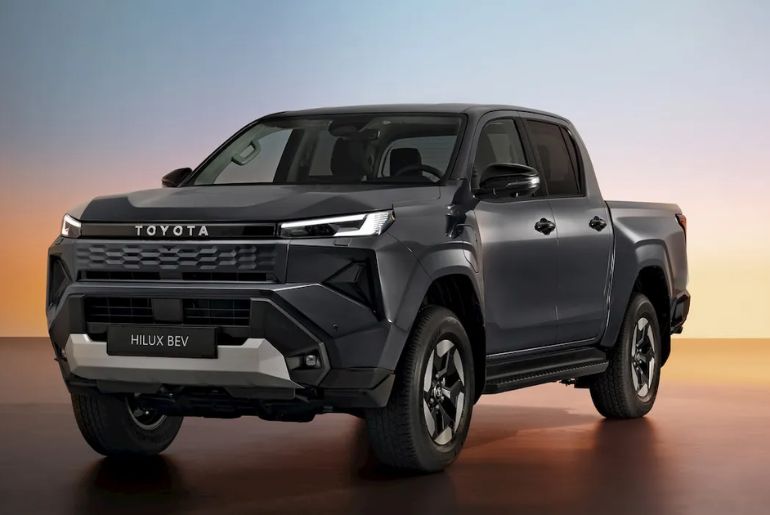In a significant stride toward electrification, Toyota Motor Corporation has officially unveiled its first all-electric pickup truck, the Toyota Hilux BEV, marking a landmark moment in the brand’s transition toward sustainable mobility. The electric Hilux, a battery-powered version of Toyota’s globally renowned pickup, reinforces the company’s multi-pathway strategy for achieving carbon neutrality while maintaining its legacy of durability and performance.
Toyota Hilux BEV: Power, Design, and Utility
The Toyota Hilux BEV is built on the same rugged body-on-frame platform as its internal combustion counterpart but powered entirely by electricity. It features a 59.2 kWh lithium-ion battery pack paired with dual electric motors providing all-wheel drive capability.
Toyota estimates a WLTP-certified driving range of around 240 km (150 miles), designed to balance efficiency and practicality. Despite its electric transition, the Hilux BEV retains hallmark pickup capabilities, including a payload capacity of approximately 715 kg, towing power of up to 1,600 kg, and water-wading capability up to 700 mm, making it one of the most rugged EV pickups in its class.
From a design standpoint, the Hilux BEV carries forward Toyota’s iconic truck aesthetics, featuring a modern closed-off front grille, streamlined LED headlamps, and a refreshed digital cockpit with the company’s latest Connected Car Interface.
Electrifying the Utility Vehicle Segment
Toyota’s launch of the Hilux BEV represents a pivotal shift in its approach to electric mobility. Long known for its focus on hybrid technologies, the company is now directly entering the electric utility vehicle market, a segment gaining rapid traction in regions like Southeast Asia, Australia, and Africa.
Experts suggest the Hilux BEV could become a game-changer for markets that depend heavily on light commercial and off-road vehicles. By combining Toyota’s proven reliability with zero-emission performance, the pickup is expected to appeal to both commercial users and eco-conscious individual buyers.
Strategic Rollout and Market Focus
According to some reports, Toyota plans to begin regional rollout of the Hilux BEV by December 2025, with initial deliveries expected in Thailand, Indonesia, and select Asian markets. The company has yet to confirm its plans for a North American launch.
Industry analysts believe the model could help Toyota compete with emerging rivals like BYD, Great Wall Motors, and Ford, all of whom are expanding aggressively in the electric truck segment.
A Step Forward in Toyota’s Multi-Pathway Strategy
The Hilux BEV aligns with Toyota’s broader multi-pathway carbon-neutrality strategy, which integrates battery electric vehicles (BEVs), hydrogen fuel-cell technology, and hybrid models to cater to diverse market needs.
Toyota officials noted that while the company continues to develop next-generation solid-state batteries and hybrid systems, the Hilux BEV is a testament to its readiness to electrify even its most iconic workhorse models.
“The Hilux BEV embodies Toyota’s vision of zero-emission mobility without compromising reliability and strength — the qualities our customers expect,” a Toyota spokesperson said during the unveiling.
What Lies Ahead
With the Hilux BEV, Toyota aims to bridge the gap between traditional diesel-powered trucks and future-ready electric workhorses. The brand’s focus on efficiency, durability, and practicality could redefine expectations for electric pickups in global markets.
While performance tests and detailed specifications are still to be revealed, the Hilux BEV’s debut underscores Toyota’s evolving commitment to electrification—and its determination to remain a dominant force in the utility and off-road vehicle segment.

